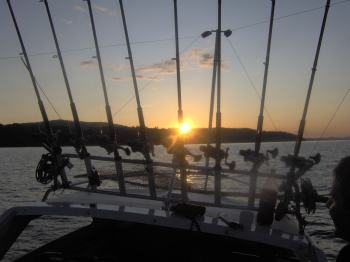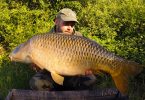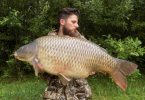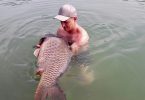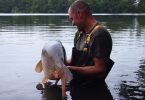Fishing during the Swedish midsummer can be an incredibly beautiful experience, especially when all the circumstances are working in your favour. Reflecting on the photos from my latest fishing trip in Sweden this past July, my mind was immediately drawn to the song “Sunrise, Sunset” from the world-renown musical Fiddler on the Roof. Though each solar event was majestic beyond description on the day, the difference in our fishing luck from sunrise to sunset was much more profound. The fiddler in the musical would have probably changed from playing melancholy at sunset to playing incredibly vibrant music at sunrise if he were a fisherman and could have been with us on that magical morning.
 Fishing Lake Fryken Overnight
Fishing Lake Fryken Overnight
Sunrise or Sunset?
The only way to distinguish a sunrise and sunset in Sweden at 60 degrees latitude during midsummer is to consider three important things. First, sunrise and sunset are separated by a relatively minor deviation in the direction of the event from northwest to slightly northeast. Secondly, you need to be aware of the time of the sunrise or sunset – separated by no more than several hours. Finally, you should never forget that mist usually forms in the early morning as the lake’s warmth surpasses the outside air temperature during midsummer. Whether sunrise or sunset is occurring, the soft golden light from the sun basks a fisherman in a magical display of Sweden’s midsummer beauty.
My Swedish friend, Henrik, and I heard a fishing report from our friend and professional fishing guide Anders. He happened upon a lot of fish the night before, including a number of large walleys (“gös” in Swedish) and a 25 pound pike. We decided it might be a good idea if we accompanied him during a night out on Lake Fryken in Varmland Province, just north of Karlstad. His boat had a 140 horse motor and was well rigged for the occasion. I stopped counting at around 150 when we loaded his cache of lures into the boat. Real fisherman probably need more than the few red and white spoons and snarled monofilament that usually reside in my tackle box. Each of Anders’ lures followed a relatively simple design concept, not surprisingly shaped as a six inch effigy of a perch or similar fish – the main food source for both large pike and walleye.
Lake Fryken is a finger lake running from North to South through a long valley. The lake starts at its northern most point in the town of Torsby where the famous or infamous (depending on your view) former English football coach Sven Goran Eriksson grew up. Lake Fryken is roughly divided into three contiguous sections as it flows southward. Upper Fryken is situated in the northern town of Torsby; Middle Fryken slips through a small channel just near the town of Sunne; and finally, Lower Fryken resides at its southernmost point near the town of Kil. No matter which direction or town you start from, Lake Fryken is a Swedish treasure for anyone lucky enough to behold its opulence.
 Our guide and friend Anders
Our guide and friend Anders
The fishing trip sounded truly exciting given Anders’ good catch the night before. His catch even included some very large walleyes, my family’s traditional favourite freshwater fish. We were all keen to get started as soon as possible and decided to put the boat in below the town of Sunne on Middle Fryken at approximately 7:30 pm. We didn’t know at the time that our first real strike would not happen until 4:30 am when the sun had reappeared. We had been fishing for more than 9 hours by that time and the fish were finally starting to get hungry. Then again, we really didn’t care much about time given the majestic and tranquil surroundings of Lake Fryken.
Does Size Matter?
My daughters Hanna and Elsa were fortunate enough to have gone fishing the prior week on Pine Lake, one of my Grandfather’s favourite lakes in northern Minnesota just outside of the town of Gonvick. My sister and her family were with us. We caught a good number of pike and other species of fish including smallmouth bass and walleye. The action in Minnesota was more or less continuous although the pike were quite small due to the freeze-outs that happen from time to time on shallow lakes when the temperature is very cold for an extended period of time during the winter.
 Pike, smallmouth bass and walleye – a morning fishing on Pine Lake
Pike, smallmouth bass and walleye – a morning fishing on Pine Lake
The relatively small size of the pike consistently caught on Pine Lake the week before did not compare to those inhabiting Lake Fryken in Sweden. Big pike and walleye do in fact exist in Pine Lake. Otherwise the photos in the local stores would be fabrications and my Grandfather would have needed to fake the 30 stitches in his hand from mistakenly trying to horse one over the side of his boat when he forgot his net ashore. Perhaps a freeze-out leaves the fish population in disarray but for the deep holes unaffected if they are lucky enough to reach them in time.
The size issue would never have been a problem if Gonvick’s beautiful lake was not a remnant glacial lake, with a maximum depth of 3 to 4 metres. Lake Fryken, filling a deep valley, reaches depths of more than 100 metres in its uppermost parts. Ultimately, both the Minnesotan and Swedish pike and walleye fishing experiences were superb beyond words. Ranking them would require a resolution of the age-old fishing debate of action versus size to truly compare the two trips. Perhaps it is best not to even try.
Sunset
In the northern latitudes during the Scandinavian summers, sunsets happen over an extended period of time. On Lake Fryken, the sun moves across the sky in a very sublime and slowly descending fashion until it meets the ridge of the Fryken valley (imagine an inverted and slightly parabolic arch if you will). The sunset can seem to last for hours on a clear evening during midsummer in a manner most western Europeans and Americans (other than those residing in Alaska) have never witnessed. This creates a sensationally long twilight period and an extended, golden sunset or sunrise on a cloudless day. This day was just such a day and we sat back and witnessed the full visual effect. I knew what to expect having been much further north than 60 degrees latitude. During my college summers in Alaska and Norway, I spent a great deal of time enjoying places where the sun never even sinks below the horizon.

Sunset on Lake Fryken
Supposedly, fish are hungry when you are hungry (okay, at least according to one of my brother-in-laws). Unfortunately, the fish didn’t seem as hungry as we were at sunset. We shared a few sandwiches and then the sun did eventually set without so much as a minor strike except for one extremely optimistic perch that hit one of the lures. The remarkable thing was that the lure was the same size as the fish. Given the size of their brains, I am not certain if fish actually know what size they are – something that was probably responsible for that perch’s mistake.
We were fishing with eight rods and also dealing with a very high volume of water flowing through the Fryken valley due to recent heavy rain, creating considerable debris in places on the water. Anders, who had been out the night before until 7:00 am, would not even contemplate the idea of going in until we had at least made it through to the extended sunrise period. His persistence and wisdom from years of fishing the lake resulted in us ultimately catching some very big fish.
 The View North towards Torsby in the middle of a midsummer night
The View North towards Torsby in the middle of a midsummer night
As the sun finally dipped a good bit below the horizon, monitoring the rods became increasingly difficult. Fortunately, the fish weren’t that interested in our lures anyway and we spent the next few hours looking to the north beyond Torsby at the illuminated sky which never truly darkened throughout the night. The only sounds were the slight hum of the motor trolling at 2 kilometres per hour and the gentle flow of the water slipping past the hull. At such times, your mind tends to go into a contemplative mode that simply reflects on life and existentially enjoys the experience of being out on the lake.
Sunrise
What a difference a few hours can make in the appetite of fish. We were all rather drowsy from the relative darkness of the temporary twilight cond-itions although each of us was still very keen on fishing. Then again, at 3:00 a.m. it was me who first queried whether we should perhaps call it a day. The damp coldness of the night after sunset was beginning to set in my bones. Anders politely indicated to me that calling it quits at 3:00 a.m. was not really an option. He saw the clear sky above him and knew that the morning sunrise would provide us with an entirely new opportunity to catch fish. He was right of course.

A Misty Sunrise or Trouble Brewing?
As the sun slowly crept up towards the horizon, it was easier for us again to monitor the eight rods tracking their lures. We could also more easily deal with the debris that was flowing through the lake from the recent heavy rainfall. We cleared the lines of weeds and debris a few times in the early morning hours on each side of the boat in an attempt to be diligent and increase our chances. As it turned out, the lures were relatively weed-free given the long metal leaders we were using. Over the course of the next hour, the light improved so much that we were then easily able to see whether any of the rods were snapping into action.
Finally, the sun slid up across the horizon and gave us not only illumination but some much appreciated warmth. What an incredible feeling it was to see the sun finally emerge from behind the north end of the Fryken valley. At that time, we were all borderline freezing and hoping for a bit of action to get our blood pumping again. And that is precisely what happened.
The Strikes Begin
At 4:30 a.m. the string from one of the rods flew off the main rig, meaning either we had hooked some heavy debris or we had a good fish on the line. As we soon learned, it wasn’t debris. Rather, we were into a pike that would have made my friends and family from Minnesota very, very jealous. Anders gave me the rod and the fish fought hard, as pike are famous for. I kept the drag very light knowing the power of these strong fish and let him run as much as he wanted. After a while, he began to tire and soon the reel distance monitor was gaining metres on him and we tightened the drag with each minute that passed. A few minutes later he was in the net and we had our first big catch a good nine hours after we had started. Persistence pays off when you know you are in the right conditions.
After another half hour, another line shot off the main rig. This time my friend Henrik took the rod. The fish was clearly a pike based upon how it reacted and it was also very large by how the rod and reel reacted. In the increasingly misty morning light, we were ultimately able to see the exceptional size of the fish just before Henrik lost it before we could get it into the net. This all happened despite Henrik’s incredible prowess as a top rate fisherman (editorial note – he made me write that last line).
Not to worry though, another strike came within minutes as we watched in splendid joy as the line snapped off the main rig. This fish fought hard but in an entirely different fashion from a pike. Pike are angry from the beginning and fight from the moment they are hooked until they are either free or have exhausted all their resources. Other fish such as walleyes fight intermittently and perhaps more cleverly toward the end. As noted before, walleye are called “gös” in Swedish but are clearly the evolutionary equivalent of the most delicious fish available where I grew up in northern Minnesota.
Everything can seem under control when you are landing a big walleye until it first approaches the boat. At that time, the fish will finally realize it needs to use whatever resources are at its disposal to stay out of the net. We ultimately landed Henrik’s walleye after some last minute desperate manoeuvres by the fish. A bit later in the morning, I lost a walleye just behind the motor after a good 15 minute fight. I know Henrik will never admit it but he knows in his heart that it was much bigger than the four kilo walleye he had brought in.
 More than just pike
More than just pike
To complete the magical morning of fishing, soon afterwards another one of the lines snapped off the main rig. As the morning mist set in, it was increasingly hard to see precisely what was happening. By the manner the fish fought, we were pretty sure we were dealing with a big pike. I kept the drag very low and the line taut until the energy
seemed to start to run out of the fish.
After more than a courageous struggle, once again the metre gauge in the reel showed that we were gaining line slowly. A few minutes later the pike jumped out of the water, as if releasing the last bit of its strength. Soon afterward, Anders had him in the net and we had our second large pike of the trip. Thanks to Anders, we were fishing with high quality rods and reels and that, in the end, made a huge difference in our ultimate success. In my youth, the rod or the reel would have given in long before these huge, beautiful fish.
 Kilos of pure dynamite
Kilos of pure dynamite
The Blanketing Mist and Journey Home
After being out on the lake for nearly 13 hours and shivering as we trolled through the mist, we finally decided it was indeed time to head homeward (or reach a comatose state from hypothermia). The mist, which was very beautiful as it descended from the top of the Fryken valley, now coated the surface of the lake. Without GPS, we probably would have spent the better part of the rest of the morning trying to work our way back to Middle Fryken and the town of Sunne.
Even though we were powered by a 140 horsepower motor that could achieve some incredible speed, we took the journey homeward very, very slowly and for good reason. Our visibility was reduced to a few metres and all of our teeth were more or less chattering (whether or not any one of us would admit it).
We attempted for a while to help Anders follow the red and green channel guides as we approached the narrower bit of Middle Fryken by the town of Sunne with a heavy current behind us. In the end, Henrik and I would probably not have won any medals for bravery as we both ducked inside the boat to avoid the moist, cold morning air. Driving the boat slowly with his head just above the windscreen, we could see tears from exposure to the cold damp wind running down Anders’ face.
We eventually arrived in Sunne, unloaded the lures and fish, and pulled the boat out of the lake. Soon we were experiencing the simple joy of the warmth of the car heater as we drove back to Kil on Lower Fryken. As much as we all love fishing, what a wonderful feeling it was to get a much needed boost to our core body temperatures. No matter how cold we were in the early morning mist, the spectacular sunrise and sunset on Lake Frken and the great night of fishing will not soon be forgotten.
Scott Cameron, with photographs by Henrik Lundell

